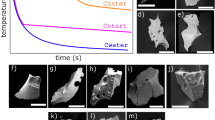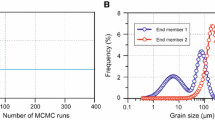Abstract
The shape of sedimentary particles may carry important information on their history. Current approaches to shape classification (e.g. the Zingg or the Sneed and Folk system) rely on shape indices derived from the measurement of the three principal axes of the approximating tri-axial ellipsoid. While these systems have undoubtedly proved to be useful tools, their application inevitably requires tedious and ambiguous measurements, also classification involves the introduction of arbitrarily chosen constants. Here we propose an alternative classification system based on the (integer) number of static equilibria. The latter are points of the surface where the pebble is at rest on a horizontal, frictionless support. As opposed to the Zingg system, our method relies on counting rather than measuring. We show that equilibria typically exist on two well-separated (micro and macro) scales. Equilibria can be readily counted by simple hand experiments, i.e. the new classification scheme is practically applicable. Based on statistical results from two different locations we demonstrate that pebbles are well mixed with respect to the new classes, i.e. the new classification is reliable and stable in that sense. We also show that the Zingg statistics can be extracted from the new statistics; however, substantial additional information is also available. From the practical point of view, E-classification is substantially faster than the Zingg method.
Similar content being viewed by others
References
Arnold VI (1998) Ordinary differential equations, 10th edn. MIT Press, Cambridge
Domokos G, Papadopoulos J, Ruina A (1994) Static equilibria of rigid bodies: is there anything new? J Elasticity 36:59–66
Ehlmann BL, Viles HA, Bourke MC (2008) Quantitative morphologic analysis of boulder shape and surface texture to infer environmental history: a case study of rock breakdown at the Ephrata Fan, Channeled Scabland, Washington. J Geophys Res 113:F02012. doi:10.129/2007JF000872
Graham DJ, Midgley NG (2000) Graphical representation of particle shape using triangular diagrams: an Excel spreadsheet method. Earth Surf Processes Landf 25:1473–1477
Gruber PM, Wills JM (eds) (1993) Handbook of convex geometry. North-Holland, Amsterdam
Illenberger W (1991) Pebble shape (and size!). J Sediment Res 61(5):756
Korn GA, Korn TM (1968) Mathematical handbook for scientists and engineers, 2nd edn. McGraw-Hill, New York
Krumbein WC, Pettijohn FJ (1938) Manual of sedimentary petrography. Appleton-Century-Crofts, New York
Mock A, Jerram DA (2005) Crystal size distributions (CSD) in three dimensions: insights from the 3D reconstruction of a highly porphyritic rhyolite. J Petrol 46(8)
Smalley IJ (1967) The presentation of subjective shape and roundness data. Sedimentology 8:35–38
Sneed E, Folk RL (1958) Pebbles in the lower Colorado River, Texas, a study in particle morphogenesis. J Geol 66:114–150
Várkonyi P, Domokos G (2006) Static equilibria of rigid bodies: dice, pebbles and the Poincaré-Hopf theorem. J Nonlinear Sci 16:255–281
Zamfirescu T (1995) How do convex bodies sit? Mathematica 42:179–181
Zingg T (1935) Beitrag zur Schotteranalyse. Schweiz Mineral Petrogr Mitt 15:39–140
Author information
Authors and Affiliations
Corresponding author
Rights and permissions
About this article
Cite this article
Domokos, G., Sipos, A., Szabó, T. et al. Pebbles, Shapes, and Equilibria. Math Geosci 42, 29–47 (2010). https://doi.org/10.1007/s11004-009-9250-4
Received:
Accepted:
Published:
Issue Date:
DOI: https://doi.org/10.1007/s11004-009-9250-4




